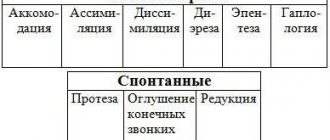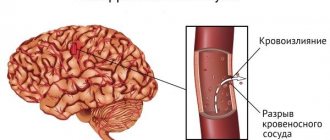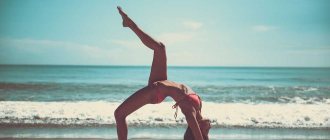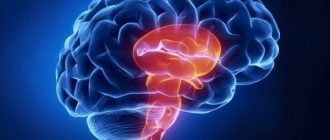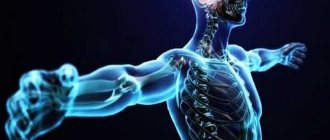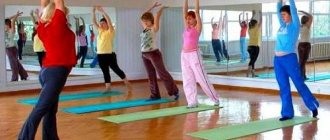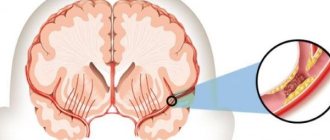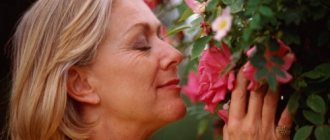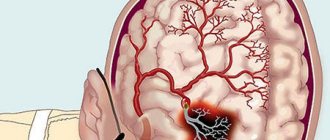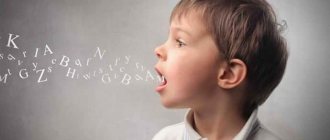After a stroke The most important means of recovery is physical therapy. After all, destroyed nerve cells cannot be restored; their functions are taken over by other brain cells. This is what therapeutic exercises serve, but to get the desired effect you must follow all the rules and recommendations.
Healing takes place in several stages. First, the person ends up in the intensive care unit, where doctors fight for his life. If successful, the patient is admitted to the neurology department, where initial rehabilitation takes place, and final recovery occurs at home. The last stage is the longest, and it determines whether the rehabilitation will be complete or partial.
What exercises does rehabilitation require?
Each type of stroke has its own exercises, but most of them are general and recommended for any type of stroke. The main thing to consider when choosing exercises is which part of the brain was damaged as a result of the stroke.
When the left hemisphere , the following occurs:
- Paralysis of the right side of the body;
- Problem with the perception of space;
- Motor memory deficit (the patient does not know how to tie his shoelaces);
- Impulsive, quick behavior.
When the right hemisphere the following occurs:
- Paralysis of the left side of the body;
- Speech problem;
- Deficit of linguistic memory (the patient is aware of the idea he wants to convey, but cannot remember the word);
- Cautious, slow behavior.
To eliminate each problem, in addition to the basic exercises, they perform gymnastics aimed at training the impaired function.
Basic rules of passive gymnastics
The exercise therapy complex recommended for recovery after a stroke is a multi-stage involvement in the activity of different parts of the brain. The main goal of physical therapy for such a disease is not to strengthen muscles and develop joint flexibility. First of all, the emphasis is on the gentle and sustained involvement of damaged nerve cells into active activity.
Despite the fact that exercises are passive in 90% of cases, their implementation can lead to fatigue of the patient. It is worth paying special attention to this, since the recovery process is not advisable to involve excessive stress for the patient.
The following can be considered passive exercises:
- flexion and extension of the limbs in the joints - first on the healthy side, and then on the paralyzed side;
- rotational movements of the limbs with a gradual increase in amplitude;
- clenching and unclenching of the hands;
- adduction and abduction of legs bent at the knees;
- breathing exercises.
At the initial stage, passive exercises also include forced extension of paralyzed limbs.
This must be done extremely delicately so as not to damage muscle fibers and ligaments! It is recommended to start extension from the fingertips.
To ensure that the benefits of exercise therapy are maximized and the risk of deterioration of the patient’s condition does not suddenly increase, the following rules must be followed:
- A set of exercises used after a stroke should be compiled by a physical therapy doctor. In this case, the choice of individual exercises will depend on which areas were damaged and how severely they were damaged.
- It is necessary to start with the simplest exercises that will require minimal stress on the patient. At the initial stage, the number of approaches should also be minimal. You can then gradually increase the load on your brain cells (but not your muscles!) by introducing a wider range of passive exercises.
- Systematicity is the key to the successful use of exercise therapy for recovery after a stroke. Exercises should be done daily, and their duration should be at least 40 minutes. It is recommended to work through each exercise as much as possible so that the brain cells can record the data received.
- Persistence is an important quality for those who help a patient during recovery. After a stroke, patients tend to become depressed and may react negatively to exercise therapy. It is important, despite the lack of desire, to carry out recovery sessions day after day until positive dynamics occur.
- Before performing the exercises, the patient must be prepared, that is, slightly “warm up” the receptors located in his skin. This can be done with a simple stroking massage.
When implementing a therapeutic gymnastic complex, it is necessary to closely monitor the patient’s physical condition. Even passive exercises can provoke headaches, increased blood pressure and other dangerous phenomena for the patient.
During the exercises, especially at the initial stage, it is recommended to monitor indicators such as heart rate, state of the eye pupil, blood pressure level and others.
How long does rehabilitation take?
Recovery depends on two factors: the location of the lesion and the actions of the patient. The more a person believes in himself and the more carefully he follows doctors’ recommendations, the higher the chance of complete rehabilitation. Sometimes the will and desire of a person play a decisive role, contrary to the forecasts of experts. Another factor is the location and extent of the affected area, as well as the time from the stroke to the arrival of the ambulance. When these indicators increase, the chance of an unfavorable prognosis and rehabilitation increases.
A stroke, which causes minor paralysis of the body and face , and moderate coordination problems, is the mildest form. With it, partial rehabilitation is predicted in 1-2 months. Full recovery occurs within 2-3 months.
A stroke with severe paralysis and persistent incoordination disorders is much more difficult to cure. Partial restoration to the level of everyday self-care at home is possible only after 6 months of training. The possibility of complete recovery is unlikely, and if it happens, it will take years.
Stroke with permanent neurological impairment (disability due to complete paralysis of any side) has the poorest prospects. Full recovery is impossible; partial recovery will be limited to the ability to sit, and this will only happen in a year or two.
It should be clarified that after any stroke, the treatment period lasts a lifetime and never ends . This is due to the fact that cells that have taken over the functions of dead cells cannot replace them 100%.
A person in normal activities can behave as if he were absolutely healthy, but in extreme situations he will lack reaction and coordination of movements.
Efficiency of rehabilitation
Exercise therapy after a stroke is very useful because:
- has a positive effect on blood microcirculation and metabolism,
- relieves muscle spasm,
- restores speech, thinking and memory,
- has a positive effect on body balance and coordination of movements,
- prevents the development of congestive pneumonia, heart failure and blood clots,
- accelerates the restoration of sensitivity of the affected parts of the body,
- prevents the development of muscle stiffening,
- protects the back, feet, heels and other places from the development of bedsores,
- restores fine hand movements.
Goals of gymnastic exercises after stroke
The main task is the complete restoration of all functions. In addition, there are many secondary, no less important tasks:
- Removing high muscle tone, with paralysis the muscles are too tense, it is necessary to relieve excitability;
- Return of precision of movements;
- When warming up, the blood supply to tissues that are reduced due to impaired innervation increases;
- Prevention of bedsores: when maintaining one body position for a long time, blood circulation in areas of high pressure is inevitably impaired; changing body position prevents this.
How to do the exercises
First you need to consult with a specialist and develop an individual training program. The doctor can talk about the intricacies of any exercise and select the most useful ones based on the type of stroke. Exercises are performed with simple tasks and a smooth transition to more complex tasks.
You cannot overload a person; excessive therapeutic exercise is harmful, as is its absence. Before starting exercises, it is advisable to warm up the part of the body being trained through massage.
It is imperative to have help and support from loved ones, as well as a positive attitude towards the training process. At home, you need to help the patient, maintain faith in healing and optimism. It is important that loved ones constantly praise and emphasize the patient’s successes. Gymnastic exercises should be performed throughout life to prevent recurrent stroke.
Are there any contraindications for exercise therapy?
Exercising after a stroke is not always beneficial. Exercise therapy is contraindicated in the following cases:
- coma;
- mental disorders accompanied by aggression;
- the appearance of muscle cramps or epileptic seizures;
- the presence of severe concomitant pathologies (cancer with metastases, disseminated tuberculosis, etc.).
A relative contraindication would be recurrent stroke in old age. Doctors decide on the need for therapeutic exercises in the post-stroke period after assessing the patient’s condition.
Exercise therapy is necessary for a stroke patient. Individually selected exercises will allow you to quickly restore impaired motor functions.
Exercises to eliminate the consequences of a stroke
Passive gymnastics
Immediately after a stroke in the first days, the patient is given complete rest; gymnastics is possible, but exclusively passive. It consists in the fact that other people perform gymnastic exercises for the patient , bending and straightening his limbs. Passive physical therapy begins with the fingers, first the paralyzed hand, then the healthy one.
Afterwards they switch to rotating the hand, movements should be carried out in both directions (clockwise and counterclockwise). Then they bend and straighten their arms at the elbows, and at the end they move to the shoulders, perform movements up and down, left and right, and make rotational movements. Passive gymnastics for the lower extremities follows the same principle.
To eliminate muscle spasms, you can fix them for a short time in an extended state. The hand or fingers can be tied to a stick, securing them in an extended position; this is done with other parts of the body. Fixation can be performed for no more than 30 minutes a day, provided that the patient does not experience discomfort.
The patient himself performs “mental” gymnastics . These exercises speed up the recovery of the motor center. All you need is to mentally imagine such gymnastics. Imagining how he squeezes and unclenches his palm, the patient forms a new motor center in his head. It is important to clearly imagine the picture and visualize it as often as possible. You need to believe that everything will work out.
Active gymnastics in a supine position
- A cloth (towel) is hung over the bed. A person grabs it with his hand and develops his arm independently, bends and unbends, raises and lowers. The fabric is gradually hung higher, complicating the training process and stimulating the recovery process.
- The next device is a rubber ring with a diameter of 40 cm. The ring is placed between the limbs, the person’s task is to stretch it. The ring for this purpose is made of medium thickness, so that spreading the limbs apart is quite simple and difficult at the same time.
- The patient, with a smooth movement, grabs the headboard of the bed and tries to pull himself up or push away from it. It is useful to involve your legs in this process.
Active gymnastics in a sitting position
- The patient sits on the bed, lowers his legs to the floor, and holds onto the bed with his hands. The task is to bend your back, sticking out your chest. Bend as you inhale, relax as you exhale.
- The patient sits on the bed, legs also lie on the bed. The task is to raise straight legs, one by one, first one leg, then raise the second.
- Another exercise in the same position. To relax your back, place a pillow under it. The task is to reach your chest with your knee, clasping your leg with your hands. Raise your leg while inhaling, hold the movement and breath at your chest for a couple of seconds. Do it alternately for each leg.
- A person sits on the bed, legs rest here, arms are pulled back, palms rest on the bed. The task is to inhale and try to connect the shoulder blades with each other. At the same time, tilt your head back.
Active gymnastics standing
- Lift a small object (a box of matches, a pencil) from the table; after successful completion, you can lift the object from the floor.
- Raise your arms up and stretch, standing on your toes. Do the exercise while inhaling, relax while exhaling.
- Feet shoulder-width apart, palms on waist. Tilts forward and backward and left and right.
- Stand up straight, stretch your arms forward, exercise “scissors” for your hands.
- Place your feet together and squat, trying to maintain a straight posture and not lift your heels off the floor.
- Place your feet shoulder-width apart, hands on your waist, rotate your torso clockwise and counterclockwise.
- Walking while standing still.
- Swing your leg, clapping your hands underneath it.
In general, you can do any gymnastic exercises from the school curriculum.
After recovery
When the patient can fully walk and move, regular exercise is necessary. An excellent option is the popular Nordic walking. It will help keep the body in good shape and maintain normal blood circulation throughout the body. In addition, Nordic walking is performed in the fresh air, which is also a definite plus. Choose poles of optimal length and comfortable sportswear and shoes and go for a walk.
Don't forget to do 20 minutes of exercise for your whole body every morning. It is not necessary to perform heavy exercises at a fast pace. Your task is to stretch your muscles and joints so that they do not lose their mobility. Perform basic exercises smoothly and measuredly.
An excellent solution for those who have suffered a stroke is yoga. This is a good way to completely recover, return to complete harmony and agreement with your own body, and even expand its capabilities. Of course, you need to get approval from your doctor for classes.
As an option - exercises on simple simulators. A stepper, an elliptical, an exercise bike and a treadmill (for walking only) are best suited for these purposes. Low-intensity exercise with these machines can also help you stay mobile and active after a stroke. Do not forget that a rich diet, regular brain activity and taking medications that support health should go in combination with exercise therapy.
The worst is over; relatives know that a loved one survived a stroke and is preparing to be discharged. At home, they wait and arrange the premises, and doctors prepare a list of things necessary for rehabilitation, which includes gymnastics after a stroke. Exercise therapy is often perceived as something secondary and it seems that pills and massage are more necessary, but this is a mistaken opinion. Let's see how important therapeutic movements are in the post-stroke period and the rules for motor rehabilitation.
Therapeutic gymnastics for the face, tongue
These exercises are intended for patients with impaired speech apparatus functions. Often the return of speech is slower than motor skills and may take several years. The main condition for successful healing is that a person must hear live human speech more often (not on TV) . At home, relatives should constantly communicate with the patient.
Exercises for facial muscles and tongue
- Show your tongue, stretch it forward as much as possible;
- Lick your lips, counterclockwise and clockwise;
- It is easy to bite the upper and lower lip alternately;
- Grin;
- Curl your lips into a tube;
- Click your tongue.
Exercises to regain the ability to pronounce words
- We start with the pronunciation of individual sounds (alphabetically);
- After this, we learn to pronounce simple words (mom, dad) or the roots of complex words, without endings;
- Afterwards we train the correct pronunciation of full words;
- In conclusion, you can practice pronouncing tongue twisters and rhymes.
Recommended sets of exercises for recovery at home
After a stroke attack, it is necessary to train all parts of the body, but exercise therapy after a stroke is selected so that maximum correction of possible movement disorders occurs.
Improving the functioning of the vestibular apparatus
Balance and coordination exercises are necessary for people who have difficulty maintaining an upright position while walking.
Exercise therapy for stroke for balance consists of relatively simple movements:
- Standing, rest your hands on the back of the chair. Stand on 1 leg for half a minute, then change limbs. Gradually, the duration of standing should be increased to 2 minutes and not use your hands to maintain balance.
- The following coordination exercises will be a more complicated version of the previous movement - you need to not only raise your leg, but also move it to the side, holding the raised limb for a couple of seconds, then slowly lower it to the floor.
- Walking along one line. You need to walk, placing the heel of your right foot close to the toe of your left.
At first, relatives help you do exercises to restore balance, and then the person begins to train on his own.
Eliminating problems with facial expressions
Facial exercises after a stroke are necessary when paresis of the facial muscles persists and articulation is impaired.
In case of facial deformation due to paresis, it is recommended:
- alternately frown and raise your eyebrows;
- puff out one's cheeks;
- smile.
A useful exercise for the facial muscles is to make faces in front of the mirror, trying to make the halves of the face look the same.
Almost always, a violation of facial expressions is accompanied by difficulty in articulation. Then a set of exercises for the tongue and lips will help:
- move your tongue over your lips;
- grin, showing teeth;
- stick out your tongue, trying to touch your chin;
- fold your lips into a tube.
Such rehabilitation at home will not only allow you to restore facial expressions, but also get rid of slurred speech.
Gymnastics for the eyes
Paresis of the oculomotor nerve makes it difficult to focus the gaze and causes double vision. To eliminate this, you will need a special complex of exercise therapy:
- focus your gaze on one point and blink at regular intervals;
- change the direction of gaze first from right to left, and then from top to bottom;
- rotate the pupils first clockwise and then counterclockwise;
- close your eyes, squeezing your eyelids tightly for a few seconds, and then slowly open your eyes.
An important rule: eye exercises should not overwork the organ of vision. Eye exercises after a stroke are performed slowly, with a small number of repetitions, but the movements must be done 3-4 times a day. This will help restore the functionality of the extraocular muscles and nerves.
How to plan your workouts
There is no exact gymnastics plan for restoring motor activity. Each person experiences rehabilitation after a stroke differently. Start from successes in the present tense; if the patient performs the exercise accurately enough, then you can try to move to the next stage. The number of movements and approaches for one exercise is also increased based on the patient’s well-being. Classes begin with passive training, when the patient begins to move his fingers and arms, you can move on to active exercises in a lying position.
If a person performs all active exercises in a lying position with good accuracy, then switch to exercises in a sitting position. Initially, you will have to be present during such activities and support the patient so that he does not fall . Progress should not be artificially delayed. If the patient easily performs tasks in a lying position, but has difficulty coping with sedentary exercises, then you need to train hard while sitting, and the result will definitely come.
If speech function is damaged, tasks to restore it should be performed from the first days of rehabilitation.
There is no need to differentiate between individual exercises. If the patient can move his arms, but is unable to do the same with his legs, then the arms should be developed with active gymnastics, and the legs with passive gymnastics. If a patient performs one sitting exercise well, but gets excessively tired from another, then you can include only the resulting task in the lying gymnastics, and wait with the others.
During the first active training for any exercise, the number of arm movements is 1-2, legs – 3-5. Gradually increase the number to 5-6 for arms and 14-16 for legs. The amplitude and speed of movement also need to be increased gradually. The number of classes at the beginning of rehabilitation is strictly once a day , after which it can be increased to 2 times, but only if you feel well.
CHARGING complex
After warming up, you can start doing exercises.
Exercise 12 (with a rubber expander attached to the wall at chest level).
- We perform it while standing, facing the expander mount.
- toes and heels together to practice balance.
- I stretch my arms out in front of me. I do not create much tension on the rubber bands.
- I spread my arms to the sides/sides. It's like opening a hug)))
- I bring my hands back to the starting position.
- When performing the exercise, I do not bend my arms at the elbows, I keep them straight.
- I make the movement in the horizontal plane.
- three sets of 15 repetitions.
Once every two weeks, add one repetition in each approach. We reach 25 repetitions in each approach.
Exercise 13 (with a rubber expander attached to the wall at chest level).
We perform it while standing with our back to the expander mount.
- toes and heels together to practice balance.
- We stretch our arms to the sides. We create a slight tension on the rubber bands. Like open arms.
- I bring my hands together in front of me. Like clapping hands)))
- When performing the exercise, do not bend your arms at the elbows, keep them straight.
- We make the movement in the horizontal plane.
- three sets of 15 repetitions.
Once every two weeks, add one repetition in each approach. We reach 25 repetitions in each approach.
Exercise 14 (with 6 kg dumbbells)
- We perform standing, legs slightly narrower than shoulders.
- arms along the body. Dumbbells in hands. OVER GRIP.
- arm raises with dumbbells to the sides and up. To shoulder level.
- We perform lifts smoothly. When we lower our hands down, we take a short pause (1 second) in each approach.
- 5 reps x 3 sets.
Once every two weeks, add one repetition in each approach. We reach 25 repetitions in each approach.
Exercise 15 (with 6 kg dumbbells)
- We perform standing, legs slightly narrower than shoulders.
- arms along the body. Dumbbells in hands. GRIP FROM BOTTOM.
- arm raises with dumbbells to the sides and up. To shoulder level.
- We perform lifts smoothly. When we lower our hands down, we take a short pause (1 second) in each approach.
- 5 reps x 3 sets.
Once every two weeks, add one repetition in each approach. We reach 25 repetitions in each approach.

